Omaha Poker Rules – How to Play PLO Poker
 Reviewed by Chris ‘Fox’ Wallace
Reviewed by Chris ‘Fox’ WallaceBeginner-friendly
8 minute read
Omaha is one of the most widely played poker games in the world, probably second only to Texas Hold’em in terms of popularity.
Pot-Limit Omaha Poker – Video Guide
How to play Omaha poker
You may have heard it described as ‘PLO’ or ‘PLO poker’, which stands for Pot-Limit Omaha, as this particular game is most often played in the pot limit format. The rules are a little different, but the good news is that if you’ve already played Texas Hold’em, PLO poker rules are going to be really easy to pick up.
What Is Pot-Limit Omaha?
Think of PLO poker as Texas Hold’em with a twist! The structure of the game is identical:
- The deal
- The flop
- The turn
- The river
- Showdown
As you can see, this is the same order of play that you’d find in a game of Texas Hold’em. The key differences in Omaha are that:
- Each player receives four hole cards, instead of two
- Exactly two of those hole cards must be used to make your five-card poker hand
At first glance this may not seem to be a big change, and it’s true that players with experience in Hold’em are able to adjust to Omaha poker rules fairly easily. In fact, if you’ve only played Texas Hold’em the sudden doubling of your hole cards can make you feel like you have superpowers!
And that’s the key point: when you hold extra cards, the different poker hands you can make have the potential to be stronger, plus there are more of them possible in every hand. But don’t forget, that’s the case for your opponents too.
Omaha Poker Rules – A Step by Step Example
Let’s watch as a hand of PLO poker plays out, step by step. This example is from a six-handed Pot-Limit Omaha cash game, with blinds of $1/$2.
1. Pre-Flop
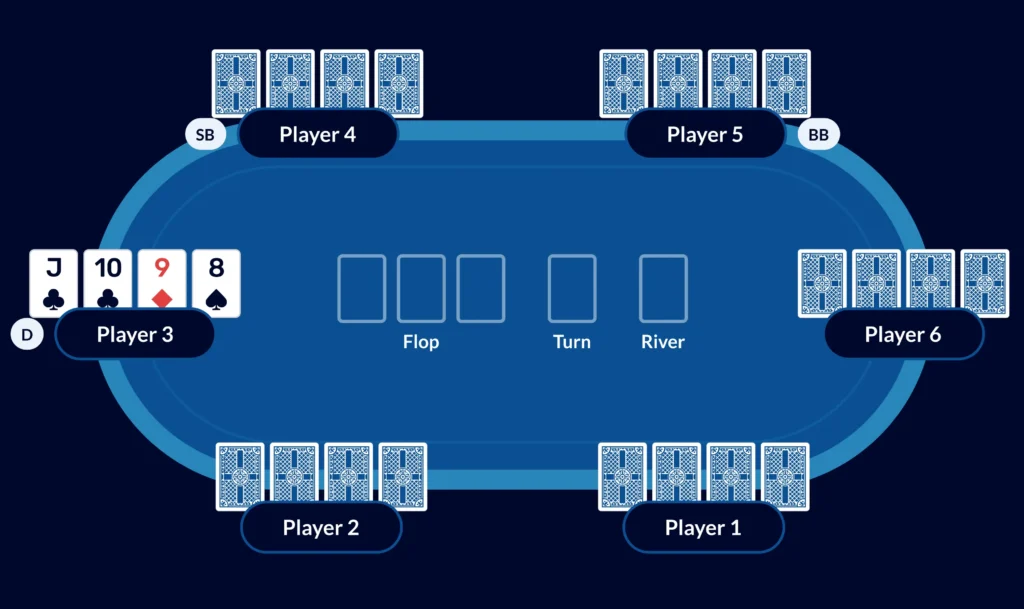
Every player receives four hole cards, which can only be seen and used by them. The player to the left of the dealer puts in the small blind, the player to their left puts in the big blind, and the remaining players must call that forced bet to stay in the hand.
In this example, the player in early position raises and is called by the button, with J-T
-9
-8
, and the big blind.
2. The Flop
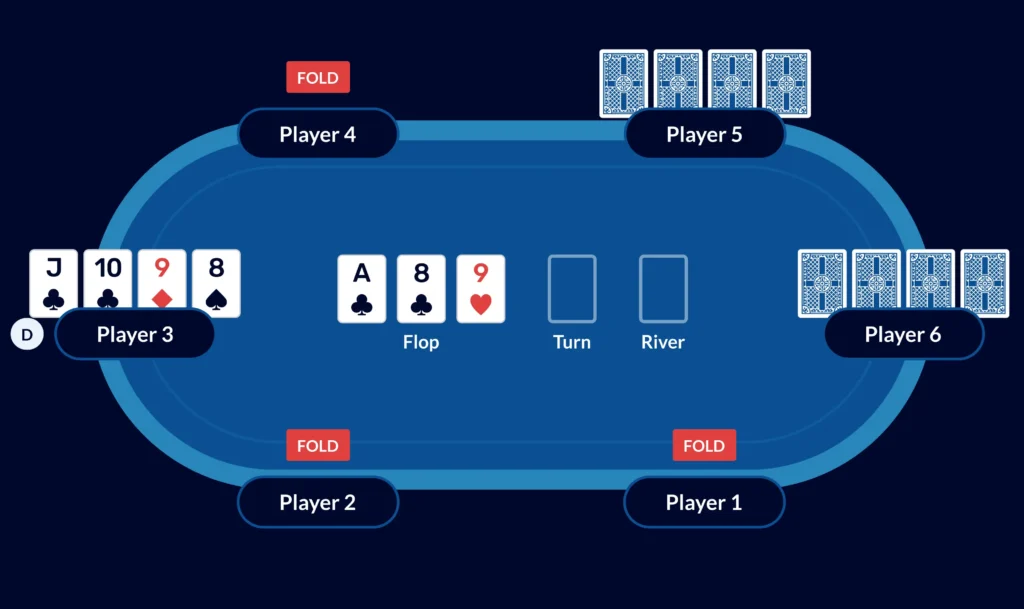
Just as in Texas Hold’em, the dealer spreads three communal cards in the center of the table, for all players to use. Unlike in Hold’em, however, players already have various options for different hands they can make, given that they have a choice of four hole cards from which they must use two to make their hand.
The big blind checks and the pre-flop raiser puts in a bet. The button has flopped bottom two pair, with a lot of potential to improve even further to a straight or a flush, so makes the call while the big blind folds.
3. The Turn
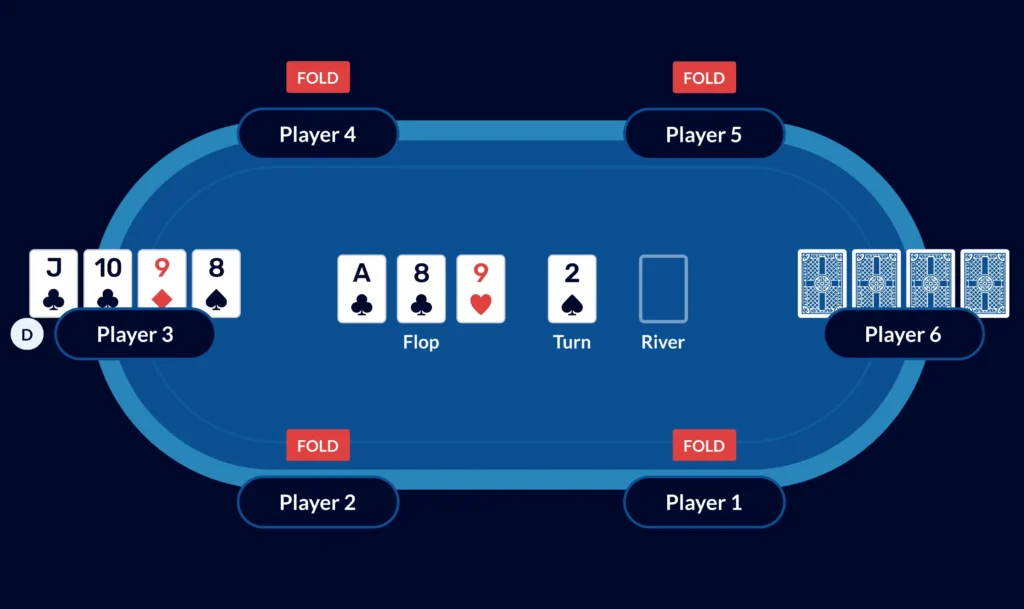
Another communal card is added to the board, following by a further round of betting.
This turn card doesn’t seem to change much. The player in early position makes another bet and the player on the button, still looking to improve on their two pair, makes the call.
4. The River
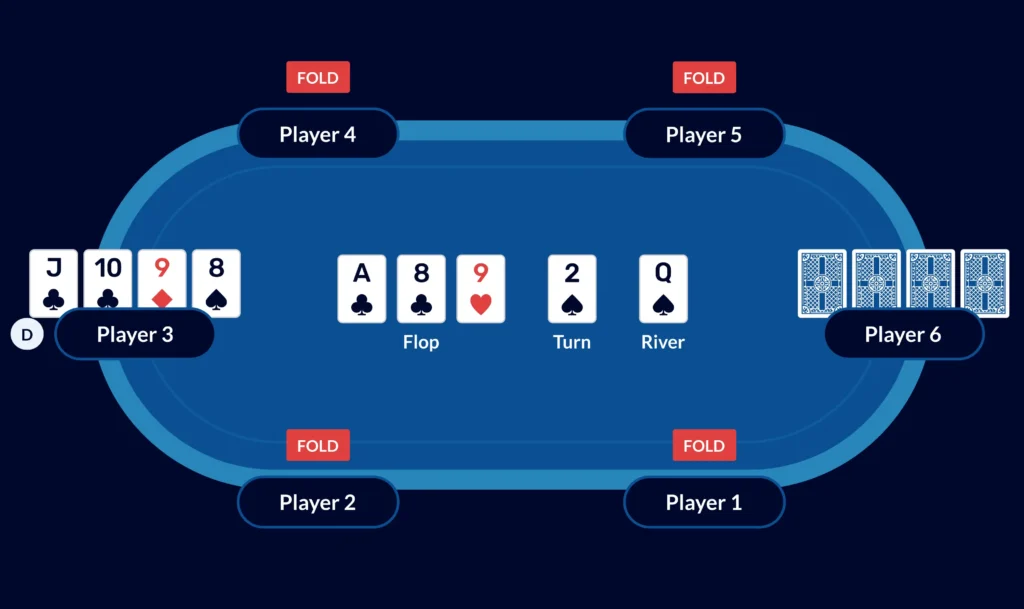
Just as in Texas Hold’em, the river is the final community card to be dealt, and is followed by the final betting round.
The early position player bets out again, only to be raised by the player on the button. The original bettor likes their hand enough to call, and the hand heads to a showdown.
5. The Showdown
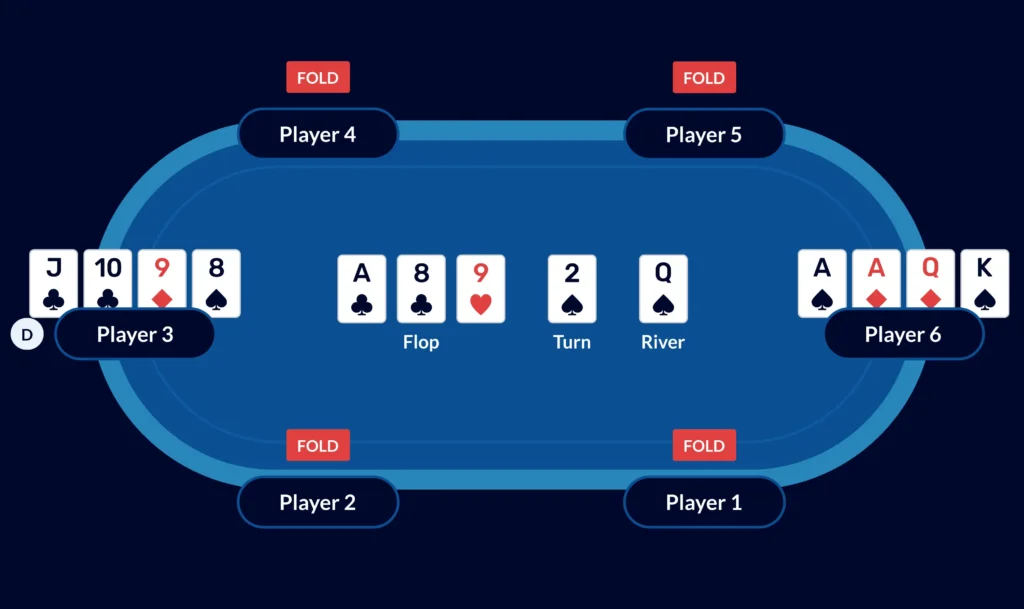
When betting is complete, all remaining players reveal their hole cards. The player with the best hand – using exactly two of their hole cards and three community cards – is the winner.
In our example we can see that the early position player started off with a pair of aces (which were also ‘double-suited’, meaning they had the potential to make a flush with two different suits). They then improved to three-of-a-kind when the flop brought a third ace, and bet to try and force out any drawing hands.
The player on the button, however, had the potential to improve to a straight or a flush, eventually using their T-J
to make a straight (8
-9
-T
-J
-Q
) on the river and scoop a big pot.
It might seem at first glance that the player in early position has a full house, aces full of queens, but don’t forget that each player has to use exactly two of their hole cards, so the best hand this player can make is actually three aces.
Ready to play? Compare the best Omaha poker sites first.
How Does Omaha Poker Differ From Texas Hold’em?
As we’ve seen in the example hand above, Omaha plays very similarly to Hold’em when it comes to the structure of the game. But the small changes in Omaha poker’s rules – adding extra hole cards and always using two of them – are just one part of what makes Pot-Limit Omaha a whole new game to play. Let’s take a closer look at how these very similar games can be so different.
What Does Pot-Limit Mean?
If you’re familiar with No-Limit Hold’em, you’ll know that part of what makes it such a fun game is that you can bet your entire stack of chips at any time. That’s what puts the ‘no-limit’ in ‘No-Limit Hold’em’! Pot-limit, on the other hand, means that the maximum anyone can ever bet at once is limited by the size of the pot. Here’s an example of how to calculate Pot-Limit Omaha maximum raises:
- Player A puts in the small blind of $1.
- Player B puts in the big blind, $2.
- Player C wants to raise the maximum, calculated as follows: $1 (small blind) + $2 (big blind) + $2 (Player C’s call of the previous bet) = $5. To raise the maximum, Player C must put in $7 (the $2 call plus the $5 raise). The size of the pot is now $10.
- Player D also wants to raise the maximum, calculated as follows: $10 (the existing pot) + $5 (Player D’s call of the previous bet) = $15. To raise the maximum, Player D must put in $20 (the $5 call plus the $15 raise). The size of the pot is now $30.
If this seems a little too tricky to figure out in the heat of the moment, don’t worry – you’re not alone! Luckily, when playing PLO poker online you can simply click the relevant button for a maximum raise and the software will do the calculations for you.
Why is Omaha Played as a Pot-Limit Game?
‘Betting the pot’ is a common move in PLO poker and, as you can see from the example above, can lead to some very big pots, very quickly! Big bets are therefore quite common, which is interesting because Omaha poker is a game where drawing hands are valued more highly than in a game like Texas Hold’em.
This is because the extra hole cards in Omaha provide so many more combinations: pairs will make a set more often, and straight and flush draws are more likely to be out there too. The traditional way to protect a strong hand in poker is to bet large amounts, forcing opponents to fold their unfilled draws, but in Omaha you might flop the strongest hand there is and still not be a huge favorite to win the pot!
Take another look at the example hand above. The pre-flop raiser in early position flopped ‘the nuts’, the best possible hand at the time, which was three aces. And yet, against the various draws the player on the button had, the player with the nuts was only around a 56% favorite to win the hand.
Learning how to play Omaha poker, you’ll notice a fascinating interplay between various elements which make PLO a unique poker game:
- compared to Hold’em, drawing hands have much better potential to outdraw opponents (and often in multiple ways)
- to discourage drawing hands and protect strong hands, it’s necessary to bet large amounts
- in pot-limit games, you’re restricted in the amount you can bet
Omaha poker can be played online in no-limit formats, as well as in limit games in some places, but Omaha’s special formula outlined above makes it a perfect fit for a pot-limit game. What’s more, the big bets and great draws that the game encourages make it a favorite of players who enjoy a little more gamble in their poker games!
Advice for New PLO Poker Players
Many players who are familiar with Texas Hold’em take up PLO when they’re looking for some novelty or variety in their ‘poker diet’ (you can find even more in our poker games list). The obvious similarities between the two games help players to make the transition, but there are some traps that Hold’em players should be aware of when trying Pot-Limit Omaha.
- Remember to use exactly two hole cards
If there are four clubs on the board and you hold the ace of clubs, it doesn’t mean you have the nut flush unless you have another club to go with it. Remember, you HAVE to use two cards, so a single hole card is no good on its own!
- Adjust what you look for in starting hands
While big pairs and high cards are particularly attractive pre-flop in Hold’em, in Omaha it’s better to have combinations of cards which work well together. A hand like A-A
-K
-K
is strong, as you have two opportunities to make a set as well as two chances to make a flush. A hand like A
-A
-4
-9
, on the other hand, has few ways it can improve and is almost 50/50 against an unpaired ‘rundown’ hand like 6
-7
-8
-9
.
- More cards means more possibilities for you
Look for hole cards that work well together, such as runs of cards in sequence (known as ‘rundowns’ – see above) and combinations that can make either straights or flushes. If you can see a cheap flop with hands like these, you should already have a good understanding of where you stand in the hand and your chances of winning.
- More cards means more possibilities – for them too!
In a game of Hold’em, facing three other players, for example, there are six cards out there to worry about. In a game of Omaha facing the same amount of opponents, there are 12 cards you must be wary of. Put simply, if three of any suit are showing on the board, it’s more likely someone has the flush, and if there’s a pair on the board, it’s more likely someone has the full house. It often helps in Omaha to assume that if there’s a possible draw on the board, someone has it!
- Adjust your bankroll requirements
Not only is PLO poker a more volatile and unpredictable game, the pot-limit format can often lead to pots much bigger than a Hold’em player might expect, given the size of the blinds. If you’re used to playing Hold’em at certain stakes, it may be wise to take a step down when trying PLO until you get used to how this game plays and can manage your bankroll properly.
Looking for More?
Pot-Limit Omaha is a great game, but there’s another Omaha game with even more ways to win in every hand! Omaha Hi-Lo is a split-pot game where the worst hand can win half the pot, leading to some spectacular and unique gameplay scenarios.
If you want to play PLO poker right now, head to our real money poker page where you’ll find the best places to play online. Want to do some more preparation before you hit the tables? Check out our Odds for Dummies page and improve your decision-making skills.
Looking to level up your Poker Skills further?